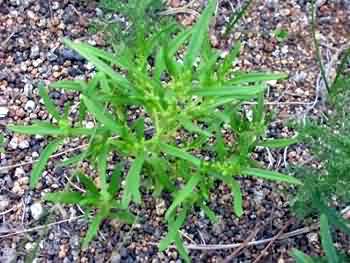Weeds
Chenopodium aristatum L. - Wormseed.
Taxonomy.
Family Chenopodiaceae Vent., Genus Chenopodium L.Synonyms.
Teloxys aristata (L.) Moq.Biology type.
Spring annual.Morphology and biology.
Plant of near spherical form is 5-25 cm high, with thin roots, 7-10 cm long and highly branched stems, which are first green, later turning red. Leaves are alternate, lanceolate or linear, blunt, entire. Lower leaves have small petioles, upper ones are sessile. Inflorescences are pyramidal, dychasially-branched. In the lower part of the plant they are bisexual, in upper part they are pistillate. Flowers are numerous, very small, sessile, located in axils of upper leafless parts of stem and branches, and terminated in small prickles. Species flowers from July until September. Seeds are black, lenticular, round, compressed from the surface. Plants are easily uprooted in strong weeds, and due to spherical-shape, become tumble-weeds.Geographical range.
Species occurs mainly in the southern part of Siberia, crossing the Ural mountains in Bashkiria, which is the west limit of the distribution of this weed. Also distributed in the northern part of Central Asia, in the Amur region and in the south of the Ussury Territory. Also distributedin northern and eastern Mongolia, northern and northeastern China, Korea, and North America.Ecology.
Species prefers sandy-loam soils of forest-steppe and south-forest zones.Seeds germinate in spring, seedlings appear in the beginning of May, right after those of cultivated plants. Seeds ripen and easily shatter before harvest time, which allows them to remain in the fields of agricultural crops.
Economic value.
Chenopodium aristatum is a segetal-ruderal weed and occurs widely in grain and tilled crops grown in the steppe and forest-steppe zones, also found in ruderal places, along roads, in young fallows and abandoned fields, along dry slopes and river banks. It is rather common in crop stubble, sometimes in great abundance. Control measures: timely cultivation of fallows.Reference citations:
Golubintseva V.P. 1936. The specific weeds of Siberia. In: Reverdatto V.V., editor. Trans.Biol.Inst.Tomsk State Univ., Tomsk. V.2: 170-227.Keller B.A., ed. 1934. Weed plants of the USSR. Leningrad: Ac.Sc.USSR. V.2: 100-101.
Komarov, V.L. & B.K Shishkin. 1936. Flora of the USSR. Moscow-Leningrad: Ac.Sc.USSR. V.6: 48.
Ulyanova T.N. 1998. Weeds in the flora of Russia and other FSU states. Saint Petersburg: VIR. 215 pp.
Volkov A.N., ed. 1935. The regions of the distribution of the main weeds in the USSR. Moscow-Leningrad: Publishing House of Kolchoz & Sovchoz Literature. 153 pp.
Yanchurkina A.A. 1975. New species of weeds in Kuibyshev region. In: Suburov V.V., editor. Species and introspecific classification of plants. Proc. of Leningrad Agricultural Institute. Leningrad-Pushkin: Leningrad Agricultural Institute. V. 267: 7-13.


